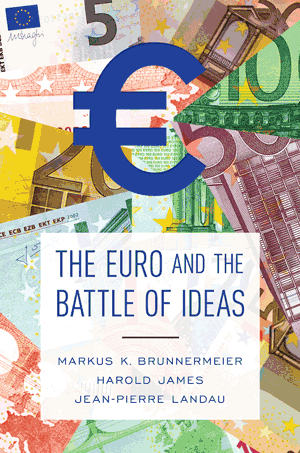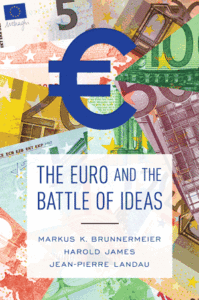
The Euro and the Battle of Ideas by Markus K. Brunnermeier, Harold James, and Jean-Pierre Landau

The Eurozone crisis has, without a doubt, greatly impacted the European Union (EU) and its Member States (MS). It has also brought to the surface the structural problems of the Eurozone itself. The Euro and the Battle of Ideas describes the origins and differences between the economic traditions of France and Germany, with the aim of examining the way these elements affected both the structure of the Eurozone itself, as well as the responses to the crisis within it. As it is argued, during the crisis, power shifted from EU institutions in Brussels to, eventually, Paris and Berlin; it became “almost an institutionalized feature of the European policy machine, to hold bilateral meetings (between France and Germany) to prepare and present common positions before any European summit” (28). Indicative of the importance placed on the French-German economic traditions is the fact that the authors designate the October 2010 Deauville meeting between the then French President and German Chancellor as the conceptual foundation for the measures to respond to the crisis.
The first part of the book traces the origins of the different economic traditions of Germany and France, highlighting that “economic thinking is shaped by historical experience” (56). The analysis also draws a bigger picture, including the differing German and French viewpoints in relation to the international economic realm (Gold Standard, Bretton Woods, etc.), highlighting the two MS’ different positions vis-à-vis the “trilemma of international macroeconomics… (whereby) an economy cannot simultaneously have a fixed exchange rate, and independent monetary policy, and allow capital to flow freely; it must pick two out of three…” (75). Both Germany and France place emphasis on an autonomous monetary policy, but the latter also emphasizes a fixed exchange rate, while the former considers free capital flows more important.
The second part of the book is devoted to analyzing the various existing differences between French and German economic perspectives across four main areas: rules vs discretion, liability vs solidarity, solvency vs liquidity, and austerity vs stimulus. The first of each is closer to the German perspective, while the second to the French perspective, with the French more likely to assume a Keynesianist perspective and the Germans likely to assume a more (neo)ordoliberal approach. As such, the French are more likely to assume a Keynesianist perspective, demonstrating discretion in the application of rules based on the events that occur, focusing more on demonstrating solidarity to their peers, viewing financial problems as liquidity rather than insolvency issues and, thus, favoring a fiscal-stimulus approach to a financial crisis. Germans, on the other hand, are likely to assume a more (neo)ordoliberal perspective, whereby rules are the fundamental elements of the system, people must be liable for their actions (moral hazard), financial difficulties are more likely to originate from solvency rather than liquidity problems, and, thus, consolidation combined with structural adjustment to improve competitiveness should be the prescribed direction out of a financial crisis. It is argued that the responses to the crisis constituted a compromise between these competing perspectives.
In the rest of the second part, and in the third part, a detailed examination is provided of the linkage between, on the one hand, various economic/political economy concepts (e.g. time-inconsistency problem, monetary and fiscal dominance, moral hazard, liquidity and disinflationary spirals, sovereign-bank diabolic loop etc.), and, on the other hand, the Eurozone and the responses to the crisis, all the while maintaining the central theme of the different economic approaches between France and Germany. What’s most interesting is the analysis is not purely evaluative, but also includes an examination of proposed policies that could be implemented (e.g. Blue and Red Eurobonds, Eurobills, ESBies, GDP bonds, etc.).
The fourth, and last, part of the book is devoted to the perspectives mostly of external actors to the Eurozone, such as the United States, the United Kingdom, China, Russia, and the IMF, although it also includes the perspectives two inside-Eurozone actors: Italy and the ECB. The bulk of this section is devoted to the pre-existing framework of, and modifications and actions taken by, the ECB during the crisis (Securities Markets Program, Outright Monetary Transactions, Quantitative Easing and Emergency Liquidity Assistance in cooperation with national central banks) with a beneficial impact on the Eurozone and a contribution in removing “the competitive difference that had built up in the first decade of the twenty first century” within the Eurozone, whereby “Germany needed some inflation and the Southern countries some deflation” (359).
The approach of the book is quite an original one in terms of scholarship relevant to the Eurozone crisis, and the book interestingly combines knowledge from the academic fields of EU politics, International Political Economy, Economics and Economic History. Furthermore, the authors utilize an effective and coherent narrative in successfully providing an explanation of the differences between French and German economic philosophies, and how those have affected the responses to the crisis within the Eurozone. This is perhaps not surprising, considering that the book pools the knowledge of three seasoned scholars of the field. The first is Prof. Markus Brunneimer, Professor of Economics in Princeton, the Director of Princeton’s Bendheim Center for Finance and, inter alia, with advisory positions to the International Monetary Fund (IMF), the Federal Reserve of New York and the European Systemic Risk Board. The second is Prof. Harold James, Professor of History, International Affairs and European Studies in Princeton. The third is Prof. Jean-Pierre Landau, Associate Professor of Economics in Sciences Po, Executive Director of the IMF and the World Bank, and former deputy Governor of the Central Bank of France (Banque de France). The theoretical but also practical expertise of the authors yields an extremely informative background upon which the analysis is built.
While addressed mostly to an academic audience, the latter part of the book sometimes feels a bit unbalanced towards favoring a banking approach to the analysis, as opposed to a fiscal or an economic one, with emphasis given on the ECB and monetary approaches focused on the banking sector. However, this effect is mitigated considerably by the focus on the differences of the French and German economic traditions, and how those materialized in relation to the Eurozone structure, presented in the first part of the book. Overall, the book offers an undoubtedly innovative and novel contribution to the relevant scholarship by outlining how the different economic traditions of France and Germany have affected not only the structure of the Eurozone but also the responses to the crisis within it, and so seems necessary for every academic that hopes to tackle the phenomenon of the Eurozone crisis.
Reviewed by Alexandros Kyriakidis, University of Macedonia
The Euro and the Battle of Ideas
by Markus K. Brunnermeier, Harold James, and Jean-Pierre Landau
Publisher: Princeton University Press
Hardcover / 440 pages / 2016
ISBN: 9781400883332
To read more book reviews, please click here.
Published on June 6, 2017.




